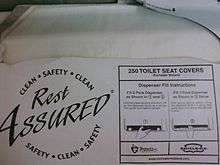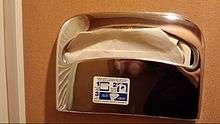Toilet seat cover

A toilet seat cover or toilet sheet is a disposable piece of paper shaped like the toilet seat itself that can be placed on the seat by its user. Its purpose is to protect the toilet's user from germs that may be resting on the seat by creating a protective barrier.
Terminology
Confusingly, the term is also sometimes used for decorative covers for the toilet seat, or even the toilet seat lid, if present. These covers generally do not serve a sanitary purpose, and may even pose difficulties with cleaning and sanitization if they are made of porous materials or are unsuitably shaped. The descriptive qualifier "disposable" is added to clarify the intended use of some toilet seat covers.
Use

Toilet seat covers are generally held in a dispenser, allowing the users to access one cover at a time, without making unnecessary contact with additional toilet seat covers.
While toilet seat covers give public toilet users a sense of security, studies have shown they do not necessarily protect a toilet user from disease. For example, if a toilet user is negligent enough to place a toilet-seat cover while the seat is still wet with liquid waste the fluids can soak through the cover and make contact with the user.[1]
Most toilet seat covers also have two sides, a shiny side that is impregnated with wax and a mild germicide and a dull side. If used properly, the shiny side should face the seat.[2]
Orientation
There has been much debate among those who use toilet covers, regarding the orientation of said toilet seat cover. The proper way to place a cover on a toilet seat is to place the side with the flap toward the front of the toilet, with the flap going in the toilet to prevent "splashing" forward. Most public toilet seats are "U" shaped with an exposed rim in the front; the flap prevents particles and germs from collecting there.
Laws

In 2009, legislators in Maine rejected legislation that would have required toilet-seat covers be placed in all restrooms. The bill was referred to the Committee on Health and Human Services, but eventually filed without further action being taken to enact the law.[3]
History
In 2007, businesswoman Jacquie Edwards of Newtonmore developed a biodegradeable toilet seat cover.[4]
References
- ↑ Roach, Mary (2000-05-19). "Ladies who spray". Salon.com. Retrieved 2012-08-20.
- ↑ Lee, Robert (2010). Standing on the Edge of Your Tomorrow Take Charge and Win!. Xlibris Corporation. p. 188. ISBN 978-1450078122. Retrieved 2013-08-15.
- ↑ "Summary". Mainelegislature.org. Retrieved 2012-08-20.
- ↑ "UK | Scotland | Highlands and Islands | Wins for loo seat cover developer". BBC News. 2007-06-28. Retrieved 2012-08-20.
External links
-
 Media related to Disposable toilet seat covers at Wikimedia Commons
Media related to Disposable toilet seat covers at Wikimedia Commons
